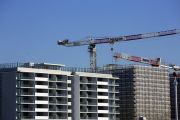
‘Rebound is here’: Office funds post first positive return in 2 years
Office towers held in the country’s biggest property funds have delivered their first positive quarterly returns in more than two years, one of the strongest signs yet of recovery for a sector that has endured steep write-downs since the rise of the hybrid working.
Office funds holding more than $34 billion in assets booked a 1.1 per cent total return over the first quarter of calendar year 2025, according to the MSCI/Mercer Australia Core Wholesale Monthly Property Fund Index.

“The rebound is here,” MSCI’s Benjamin Martin-Henry said.
“But everything is liable to change quickly given the current geopolitical circumstances we find ourselves in. But it certainly does appear to be very positive news for the office sector, which obviously hasn’t happened for quite some time.”
It is the first time since mid-2022 that those funds have been in the black, breaking a prolonged stretch of negative total returns brought on by capital declines that in some cases led to office tower values being slashed by up to 30 per cent. Even so, capital growth remained slightly negative in the quarter at negative 0.06 per cent, offset by a stronger income return.
The CBD towers, many of them landmarks, are held in unlisted vehicles run by some of the country’s biggest property fund managers such as Charter Hall, Dexus, GPT, super fund manager ISPT and Investa.
The valuations for office blocks have suffered since 2022, as interest rates jumped, flexible working habits became entrenched and leasing conditions softened, undermining investor confidence. The downward cycle appears to be over, according to Martin-Henry.
The overall index – which tracks 15 funds with more than $95 billion of commercial real estate including malls, warehouses and office blocks – recorded its second consecutive positive quarterly total return, with Q1 2025 delivering a return of 1.2 per cent, following 0.4 per cent in Q4 2024. The overall index also recorded positive capital growth of 0.1 per cent, marking the first such increase since Q3 2022.
All the office-only funds except ISPT’s 50 Lonsdale Street Property Trust delivered positive returns during the first three months of this year.
Leading the sector was the $6 billion Investa Commercial Property Fund, which posted a total return of 2.7 per cent. The fund owns a portfolio of prime-grade towers such as 60 Martin Place and Deutsche Bank Place in Sydney, 120 Collins Street in Melbourne and 220 London Circuit in Canberra.
“We’re not surprised to see the MSCI Office Index return to positive territory this quarter — it’s another encouraging data point suggesting the worst of the prolonged market downturn is behind us for prime assets, and that we’re now in the early stages of a market upswing,” Investa’s chief executive, Peter Menegazzo, told The Australian Financial Review.
“We remain optimistic about the outlook for the prime office sector, which we believe is well positioned to deliver strong returns over the short to medium term.
“Return-to-office momentum continues to build, vacancy rates are trending down supported by improving leasing inquiry and conversion, supply remains constrained, and capital markets are showing ongoing signs of normalisation.
“Additionally, growing market anticipation of a moderate to potentially aggressive interest rate cutting cycle is expected to further support pricing recovery and investor confidence in the sector – with the Sydney and Brisbane CBD markets leading the rebound.”
Renewed confidence
The March-quarter result follows signs of stabilisation late last year, when – for the first time in almost two years – an office fund with multiple assets posted positive capital growth.
MSCI’s Martin-Henry attributed the sector’s rebound to renewed investor confidence, supported by a resurgence of office transactions in the latter half of 2024 that signalled the bottom of the cycle had passed.
Last year, Sydney’s CBD office market had more than $4 billion in core office transactions.
Key deals included Mitsui Fudosan’s $1.3 billion acquisition of a 66 per cent stake in 55 Pitt Street, Brookfield’s sale of 388 George Street for $460 million, and Charter Hall’s sale of 333 George Street for $395 million. The legwork for Daibiru Corporation’s acquisition of 135 King Street for more than $600 million, which exchanged in the new year, was also done before the end of 2024.
The office transaction pipeline has slowed markedly this year, however, with buyers adopting a more cautious stance amid continuing global economic uncertainty. In particular, volatility stemming from US President Donald Trump’s shifting tariff positions has kept capital on the sidelines.
The uncertainty may yet deliver a silver lining. “Any rate cut coming due to geopolitical tensions will be beneficial to everyone,” Martin-Henry said, noting the increased likelihood of several interest rate reductions.
For buyers, rate cuts would reduce the cost of capital and improve the viability of potential acquisitions. That in turn could widen the buyer pool, supporting firmer valuations to the benefit of office building owners. Even owners of highly leveraged assets stand to benefit from easier refinancing conditions.
The positive office sector performance was mirrored across the broader commercial property market in the first quarter. All four fund types – office, industrial, retail and diversified – posted positive total returns for the first time since Q3 2022.
Retail funds led with capital growth of 1.4 per cent, while industrial property funds provided a 1.2 per cent return, posing the question whether that sector may be overtaken by the beaten down office sector later this year.











